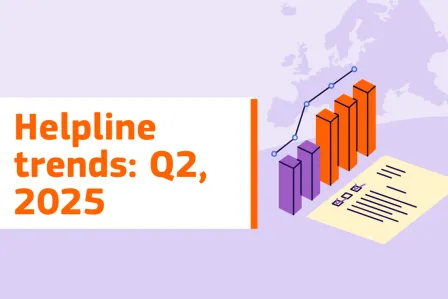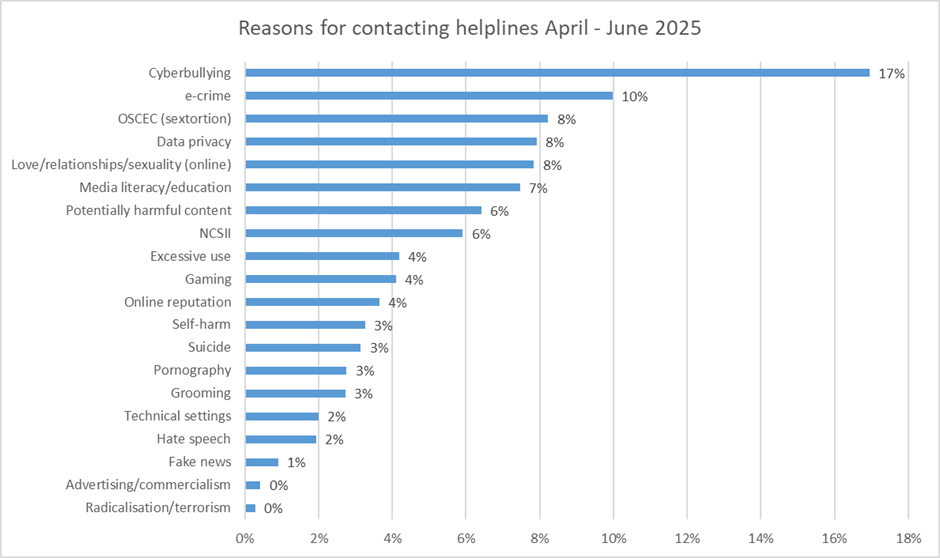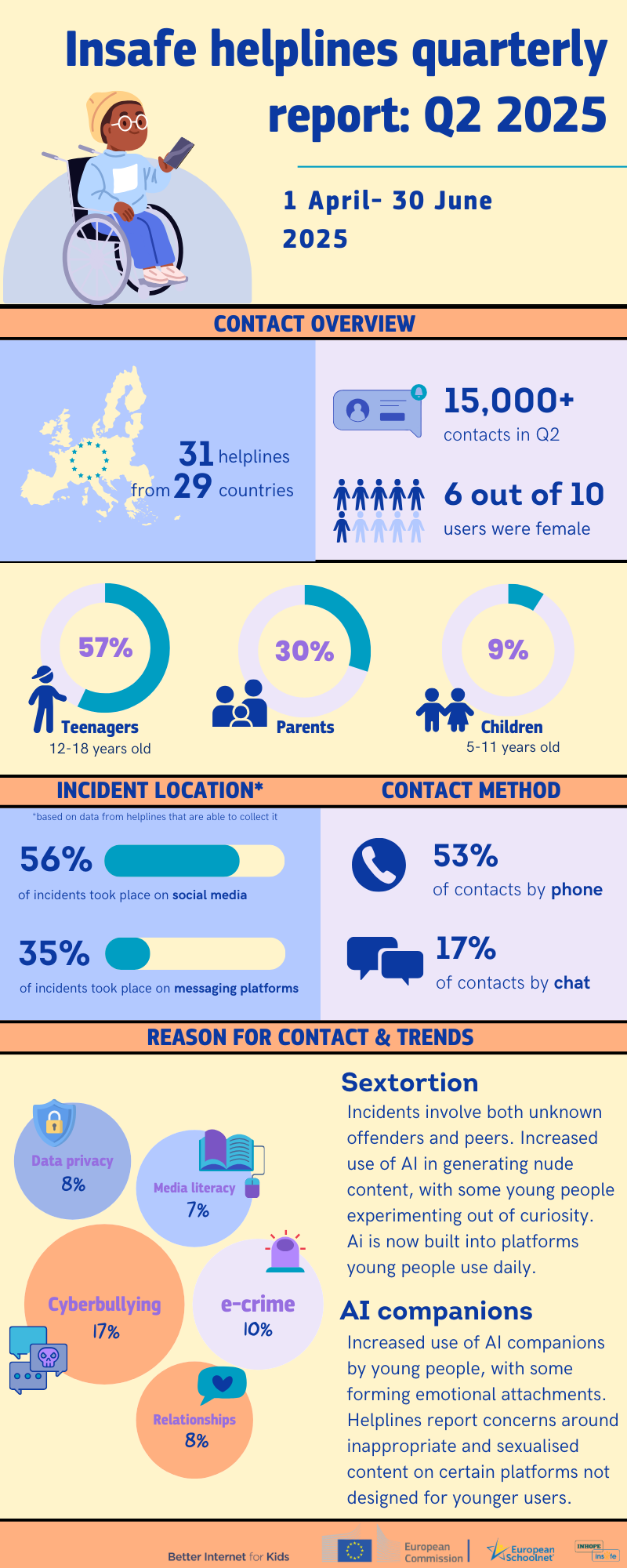The Insafe network of helplines collects data about the calls received, and this is analysed every three months in order to look at possible trends and emerging issues.

The most recent helpline data covers the period from April to June 2025. There were over 15,000 contacts made to the network, representing an increase of over 9 per cent compared to the previous reporting period. This increase may reflect several factors, such as greater awareness efforts by national helplines or emerging online trends prompting more people to seek support. However, the way helpline data is collected does not allow firm conclusions about the drivers of change.
Sixty per cent of contacts came from those identifying as female, which continues to be consistently the case over several years. Young people (aged between 12 and 18) continued to be the group most likely to use helpline services, with 57 per cent of contacts coming from this group.
In terms of types of issues reported, the online sexual coercion and extortion of children (which is sometimes referred to as sextortion) continues to be a challenge; it currently accounts for just over 8 per cent of all contacts and can happen in a number of ways. It can be perpetrated by criminal gangs who are unknown to the young person, but also by their peers, or people that they know well. Artificial intelligence (AI) is reported to continue to feature in the creation of nude content used in sexual extortion, with some young people citing curiosity as the reason that they experimented with so-called “nudifying” apps. Overall, AI is featuring in more and more helpline cases as children and young people use AI tools and products, and of course, these are increasingly being “baked” into the platforms and services they already use.
The most common reason for reaching out to a helpline is cyberbullying, with 17 per cent of contacts concerning this. The European Commission is developing an Action plan against cyberbullying and has recently concluded a public consultation and call for evidence to inform its development. E-crime accounts for 10 per cent of contacts with sextortion, data privacy, and love, relationships and sexuality (online) 8 per cent each.
Looking at how people reach out, contact by phone call is still the most popular way to contact a helpline, with 53 per cent of contacts being made in this way. Additionally, 17 per cent use chat facilities, and a further 13 per cent email or use an online form for help or support.
Helplines capture information about where a particular problem occurred (when they are able to do this and when callers share that information). During Q2, 56 per cent of issues occurred on social media, 35 per cent on messaging services, and just under 6 per cent in games. These figures should not be read as evidence that social media is inherently more harmful or games inherently safer. Reporting patterns are shaped by many factors, including user perceptions of what constitutes a reportable problem and awareness of regulatory protections across different online environments.
The table below shows the percentage of contacts assigned to each category.

| Radicalisation/terrorism | 0.28% |
| Advertising/commercialism | 0.42% |
| Fake news | 0.90% |
| Hate speech | 1.93% |
| Technical settings | 2.00% |
| Grooming | 2.72% |
| Pornography | 2.24% |
| Suicide | 3.14% |
| Self-harm | 3.26% |
| Online reputation | 3.65% |
| Gaming | 4.10% |
| Excessive use | 4.18% |
| NCSII | 5.91% |
| Potentially harmful content | 6.41% |
| Media literacy/education | 7.46% |
| Love/relationships/sexuality (online) | 7.84% |
| Data privacy | 7.92% |
| Online sexual coercion and extortion of children (sextortion) | 8.22% |
| e-crime | 9.98% |
| Cyberbullying | 16.94% |
The infographic below provides a visual representation of many of the key points in the first quarter of 2025, all in the text above, from April to July 2025.

Click the image to see the infographic in full size.
Find out more about country-based helpline services, operating as part of the national Safer Internet Centre and keep up to date with news on helpline services and trends.
The Insafe network of helplines collects data about the calls received, and this is analysed every three months in order to look at possible trends and emerging issues.

The most recent helpline data covers the period from April to June 2025. There were over 15,000 contacts made to the network, representing an increase of over 9 per cent compared to the previous reporting period. This increase may reflect several factors, such as greater awareness efforts by national helplines or emerging online trends prompting more people to seek support. However, the way helpline data is collected does not allow firm conclusions about the drivers of change.
Sixty per cent of contacts came from those identifying as female, which continues to be consistently the case over several years. Young people (aged between 12 and 18) continued to be the group most likely to use helpline services, with 57 per cent of contacts coming from this group.
In terms of types of issues reported, the online sexual coercion and extortion of children (which is sometimes referred to as sextortion) continues to be a challenge; it currently accounts for just over 8 per cent of all contacts and can happen in a number of ways. It can be perpetrated by criminal gangs who are unknown to the young person, but also by their peers, or people that they know well. Artificial intelligence (AI) is reported to continue to feature in the creation of nude content used in sexual extortion, with some young people citing curiosity as the reason that they experimented with so-called “nudifying” apps. Overall, AI is featuring in more and more helpline cases as children and young people use AI tools and products, and of course, these are increasingly being “baked” into the platforms and services they already use.
The most common reason for reaching out to a helpline is cyberbullying, with 17 per cent of contacts concerning this. The European Commission is developing an Action plan against cyberbullying and has recently concluded a public consultation and call for evidence to inform its development. E-crime accounts for 10 per cent of contacts with sextortion, data privacy, and love, relationships and sexuality (online) 8 per cent each.
Looking at how people reach out, contact by phone call is still the most popular way to contact a helpline, with 53 per cent of contacts being made in this way. Additionally, 17 per cent use chat facilities, and a further 13 per cent email or use an online form for help or support.
Helplines capture information about where a particular problem occurred (when they are able to do this and when callers share that information). During Q2, 56 per cent of issues occurred on social media, 35 per cent on messaging services, and just under 6 per cent in games. These figures should not be read as evidence that social media is inherently more harmful or games inherently safer. Reporting patterns are shaped by many factors, including user perceptions of what constitutes a reportable problem and awareness of regulatory protections across different online environments.
The table below shows the percentage of contacts assigned to each category.

| Radicalisation/terrorism | 0.28% |
| Advertising/commercialism | 0.42% |
| Fake news | 0.90% |
| Hate speech | 1.93% |
| Technical settings | 2.00% |
| Grooming | 2.72% |
| Pornography | 2.24% |
| Suicide | 3.14% |
| Self-harm | 3.26% |
| Online reputation | 3.65% |
| Gaming | 4.10% |
| Excessive use | 4.18% |
| NCSII | 5.91% |
| Potentially harmful content | 6.41% |
| Media literacy/education | 7.46% |
| Love/relationships/sexuality (online) | 7.84% |
| Data privacy | 7.92% |
| Online sexual coercion and extortion of children (sextortion) | 8.22% |
| e-crime | 9.98% |
| Cyberbullying | 16.94% |
The infographic below provides a visual representation of many of the key points in the first quarter of 2025, all in the text above, from April to July 2025.

Click the image to see the infographic in full size.
Find out more about country-based helpline services, operating as part of the national Safer Internet Centre and keep up to date with news on helpline services and trends.
- < Previous article
- Next article >












